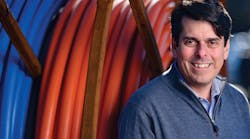Latest from C&E/NetDev Ops/GIS/Open-Source Networks
Executive Insights with Jim Capuano, CEO, Horizon
Read Jim’s perspective about network priorities, inflation of construction costs, vendor roadmaps and what our industry may be overlooking.
Topic: Priorities
ISE: What are 2 of Horizon’s network-related priorities for the end of 2021 and into 2022?
James Capuano, Horizon: Horizon’s network-related priorities are to expand our existing fiber footprint within the major metro markets that we serve, primarily in Ohio and Indiana, and to deploy fiber in residential markets throughout Ohio.
Topic: Fiber Deployment
ISE: With more than 5,500 route miles of fiber, what are some creative field solutions Horizon is employing to deploy even more fiber to its small to large enterprises and wholesale carrier customers?
Capuano: We are trying many different techniques that vary by market. While fiber construction techniques haven’t changed a whole lot over the last decade, our focus has shifted to advanced market planning and collaboration with possible anchor tenants, utility companies, and state and local government agencies.
While I said the techniques have not changed much, the equipment has improved. To take advantage of this, we also make sure we’re partnering with the best construction vendors possible. In fact, Mark Langevin, Owner of Phoenix Communications, Inc., is featured in the following photo. Phoenix Communications is one of our trusted construction vendors. Without the support from partners like this, we wouldn’t be able to bring the fiber that our communities rely on.
We have found that expansion in the metro markets for enterprise customers is more about identifying the pockets of potential customers using multiple data sets to enable us to target the addressable market opportunities. In some cases, sourcing an anchor tenant in the region has given us the catalyst to make a larger investment in a market. Unlike in the past, the one anchor opportunity typically will not be large enough to cover the entire expansion. We are not going back to the era of speculatively building without customer orders. Instead, I’d say that our methods have a larger degree of intelligence and thus far less risk.
Topic: RDOF
ISE: Horizon received $2,033,292 in RDOF funding. Congratulations! What are the best network deployment strategies providers should embrace to deliver on their commitment after receiving these funds?
Capuano: For clarification, Horizon did not receive $2 million in funding. While we did participate in the auctions, we did not "win" any of the areas.
We found that the reimbursements were bid down to a point that we didn’t believe we could make a business case work in these rural areas. Our review of the build cost suggested that would not have been sufficient to offset what we are seeing in make-ready costs. I’m sure that your readers know that make-ready is the process that new attachers follow to gain access to utility poles. The utility that placed the pole is called the pole owner and is responsible for managing any changes to them. We would pay the pole owner to make space on the pole line for our cable. The make-ready work has become more expensive in many cases than the actual construction of the new cable run.
For much of my telecom career I have worked with others in the industry to find creative ways to reduce the cost and time of the make-ready process. The FCC’s guidance on one touch make-ready has not had the effect hoped for by the telecommunications companies. The telecom companies had hoped that one touch make-ready would result in lower costs—which would have been realized by having one crew make all of the necessary moves on a pole, preventing the expense of multiple crews being dispatched overtime—and a quicker completion of the projects due to fewer mobilizations of crews to perform the work. Since 2018, when the guidance was released, we have found the cost is significantly higher and the time to complete is at best unchanged.
While we found RDOF not to be an effective way to fund rural build-outs, we have been actively working with state agencies to find creative ways to deploy more fiber into the most rural areas. As you can imagine, the more rural the area, the more difficult the economics are to make a solid business case. Our company has a history of working in rural Ohio in particular, and we’re excited about being able to help get high-quality broadband products to these underserved areas.
Topic: Growth and Balance
ISE: When a business is growing too rapidly, it can significantly increase the demands on each individual employee, and on your team as a whole. This can easily lead to stressed-out employees, low morale, and fighting among the members of your previously unified team. With Horizon’s aggressive growth targets, how do you help ensure your team is integrating networks AND employees successfully?
Capuano: I believe that company culture is critical to weathering difficult times. Our management team spends a significant amount of time soliciting and evaluating feedback from the organization. There is no replacement for leadership and quick decision-making in stressful times.
Another key is to set reasonable goals. Setting goals that are unrealistic makes the team think that the leadership team is out of touch. Not that we do not set stretch goals, it’s just that when we do, we communicate them as such. Transparency is a great way to build trust in the organization. People will strive for higher goals if they feel that the management team is shoulder-to-shoulder with them and that they are being heard throughout the process.
Topic: Labor Challenges
ISE: The US telecommunications industry employs a total of 672,000 workers, with average annual wages of $77,500. It’s forecasted that 5G rollout and other technologies could create 850,000 more "new direct broadband and 5G jobs" through 2025. Executives in the US telecom network construction sector have been arguing that they’re having difficulties finding enough skilled workers to deploy fiber and 5G networks. The CWA, which represents 700K workers in the telecom industry, says that may not be the case. What are your thoughts about this?
Capuano: First off, the labor challenge cannot be solved by telecom companies or labor unions alone. There is simply a significant shortage of people to take jobs in the United States. The number of people leaving the workforce is greater than the number joining, and the United States is going to need to come up with a plan to add people to the workforce.
It’s interesting to point out that the building trades identified the shortage of people going into their trades 10 years ago and undertook a national campaign, driven largely by the building trade unions, to attract people—especially kids heading to high school—to the advantages of working in their fields. I believe that the CWA is probably right that it will be able to fill many of those jobs considering that it has the resources to market nationally and build programs to train new personnel.
Companies like ours are working with vocational schools and local governmental agencies to build programs to attract and train people who are interested in a career path. Horizon recently announced a partnership with the Tri-County Career Center in Nelsonville, Ohio, for a fiber optic – technician training program. (See https://www.youtube.com/watch?v=wKBjbCbayxk.) The program is part of Lt. Governor Jon Husted and Ohio’s plan to bring affordable broadband to Ohio. Companies like Horizon are also going to need to establish training programs to bring in new people to fill their open positions. The ability to hire away people to fill your open positions is going to become very difficult and costly, and unlikely to be successful in the long-term.
To touch back on company culture, this is another area where culture is key—retention. As we’ve discussed, every company in the United States is finding it more and more difficult to identify, recruit, and hire, the labor that we need to be successful. Companies like ours must find ways to attract top quality talent and retain them to support our growth initiatives. Competitive benefit plans and compensation open the door to new hires, but a good culture is going to help keep them from jumping to a competitor.
Topic: Hybrid Networks
ISE: If we want to close The Digital Divide, upgrade broadband speeds, and reduce latency for end users, hybrid networks may be the answer. However, many challenges arise using hybrid strategies. In your opinion, what are some of the most daunting network-related challenges for providers as they work to scale hybrid networks? While cost is the most obvious, what other things get in the way? How can they be remedied?
Capuano: The term hybrid networks can mean something different to every network designer. As an infrastructure provider and service provider, my definition is focused on the transport protocols that we use. My experience is that the complexity of the networks is often too high, and it is largely driven by the skill sets present in the engineering teams. For instance, the methods used to build-out networks are typically based on where the engineering team began their careers. If they began their careers in Information Technology roles, routers will have a strong presence in the network. Conversely, if someone started out working on older technologies like SONET or WDM, you’ll likely start lower in the OSI stack in your designs.
I’m a big believer in simplification of network designs whenever possible. It makes troubleshooting easier for NOC personnel and field technicians, and it also makes capacity planning easier, and has a lower operating cost.
Our core network is typically designed with purpose-built links. The use of DWDM in the core has simplified the management and speed to resupply exhausted links, as well as the ability to establish express routes to reduce latency. The core IP routers connect to the core DWDM to take advantage of express routes based on traffic patterns. Core Ethernet switches also connect directly to the core DWDM and simplify the delivery of private line connections with reduced core network latency.
In our enterprise markets, edge networks must be able to support all of the services we offer and thus will result in more complexity. That said, we still try to simplify here as well. Active-Ethernet is a great foundation protocol that is used to establish links to customers and are the underpinnings for the services higher on the stack. Many of our customers order private line circuits along with dedicated Internet access, so Active-Ethernet is perfect in these situations. I believe that Dense Wavelength Division Multiplexing (DWDM)—which is used sparingly in our enterprise markets where we have high fiber counts and the distances between sites is shorter—will be used more as the bandwidth increments that customers order increase. The scale on the edge to support multiple 100GE or greater is too taxing for Ethernet networks. DWDM is the tool we use to solve large network requests.
Topic: Proactive Network Management
ISE: ICT industry analysts and observers often focus on service providers’ CapEx budgets. But the reality is that OpEx can make or break a providers’ bottom line. The key to controlling OpEx is to improve network life cycle management for complex fiber, and legacy networks in a cost-efficient manner. What are some proactive approaches you recommend to control OpEx?
Capuano: Horizon obviously has a focus on CapEx when deploying a new network, but the cost to maintain it needs to be front and center when deciding what to deploy. For example, shifting vendors is difficult to do when you factor in the investments that need to be made in maintenance contracts for sparing and management systems. I believe this is why you see many smaller and medium service providers stick to 1 equipment vendor. The 2nd- and 3rd-year costs are just too much to absorb.
Another factor in decision-making is vendor roadmaps. We need to know going in that the vendor is going to keep making investments into the platform. R&D dollars show their level of commitment. It’s also fair to point out that as the vendors roll out new cards and features, the cost for the previous cards typically comes down. We’ve tracked the rollout cost of 1G, 10G, and 100G, optics and found that with each step there was a significant reduction in the cost of the previous technology.
Topic: Overlooked Issues
ISE: What should all of us in the Information and Communication Technology (ICT) industry be talking about that we are not? Or, what current topic is the most important that needs additional and different attention?
Capuano: There is so much happening in our industry. The amount of construction that is underway, not to mention what is coming down the pipe with the additional federal money that has been approved, is going to tax every service provider. The likely inflation of construction cost will be interesting. I believe that the ability to deploy the networks is going to be limited by make-ready costs, the municipality’s ability to approve permits, the availability of construction contractors, as well as the ability to find a source for additional people to add to the job market. These are some of the same issues we experienced during the BTOP era, and we are likely to relive them again.
Topic: Your Take
ISE: Share one problem/challenge you are passionate about solving for the ICT Industry.
Capuano: Cost-effective make-ready—this one issue has handicapped our ability to overcome The Digital Divide! The federal and state money that is being awarded to service providers is not going to the fiber and optronics that are needed to provide broadband access. The funds are being spent on upgrading utility infrastructure. To be clear, I’m not grousing about the utilities. These upgrades are needed to ensure that the underpinnings of our broadband infrastructure are solid. Commercial power is equally critical to ensure this. My point is: why isn’t there a larger initiative to improve the utility rights-of-way that doesn’t saddle the broadband infrastructure provider with the cost? Much of the broadband deployment is done with private funds, and attachment costs to be on the poles have killed many business cases. Simply put, more private money would be spent on broadband deployment if not for high make-ready costs.
Topic: In Pursuit of Knowledge
ISE: What’s the best book you’ve read this year?
Capuano: The 2 I’m sharing happen to be set during the 2nd world war, but this is coincidental. The Splendid and the Vile: A Saga of Churchill, Family, and Defiance During the Blitz by Erik Larson. I’ve always been interested in the leadership lessons that can be learned from history. Churchill is a favorite of mine because of his leadership skills and ability to communicate difficult messages while motivating his followers to overcome incredible odds. Another great read is Beneath a Scarlet Sky: A Novel by Mark Sullivan. Incredible telling of the true story of Pino Lenna’s life as a young Italian during the second world war. His story to me is one of how happenstance and opportunity can lead to unbelievable achievement.
Topic: Failure
ISE: What happens at Horizon when people fail?
(Source: Bob Sutton and Jeff Pfeffer, Stanford professors via www.inc.com)
Capuano: When a failure happens, we look to find the root cause of the issue, which is typically a gap in process or a supplier issue. I’ve found that individuals are seldom directly responsible for failures in the business. My larger concern is that we have few failures due to risk-taking. We are a very conservative business; our company is over 125 years old, and that legacy has resulted in slower decision-making and less risk-taking, but in recent years we have taken on initiatives to change that. I mentioned earlier that we often build-out areas without a deal that would pay for the entirety of the CapEx. The methods we use there are designed to take some risk without removing all financial controls. We’ve had great success doing this.
Topic: NetDev Ops and Edge Computing
ISE: 5G requires edge computing—which brings content or data processing capability closer to the end user or data source so that an instantaneous, real-time response can be delivered. Virtualization makes this possible, and virtualization is a practice that sits in the domain of DevOps. By adopting cloud-native architecture, telcos can move services towards the edge of the network to provide the required latency and throughput. Share your thoughts about this and Horizon’s roadmap in this area.Capuano: Horizon is not a 5G provider. Like many fiber-based service providers, we support 5G providers by providing fronthaul and backhaul services. We see ourselves as a partner to the 5G providers, and will help enable them to deploy their services.
As an example, Horizon has been building out new markets with our FTTH team. We believe that there is a significant opportunity to offer a service to the 5G providers in these markets and have planned accordingly as we’ve deployed the infrastructure. The idea is to offer a plug-and-play option on Day One. We have increased the fiber counts and reserved space for the 5G provider colocation. 5G is an incredible product offering, but it has some well-documented limitations. We believe that FTTH and 5G will be complementary for the foreseeable future.
Topic: Connecting the Underserved for Remote Learning
ISE: According to a recent survey conducted by Digital Wish, 19% of students do not have Internet connectivity at home, and over 21% do not have access to a computing device, impacting their ability to adequately participate in remote learning. (Source: www.digitalwish.com) Horizon recently partnered with the YMCA to help keep communities connected with enhanced Internet capabilities. Share some of the new "tools in the network toolbox" Horizon used to help the YMCA. Any team members you’d like to recognize in this effort?
Capuano: Horizon is very honored to be partnered with the YMCA of Central Ohio. We were uniquely positioned to help them. Our enterprise network was located very close to their facilities, so we could provide a high-quality DIA service to them in multiple locations.
Our FTTH team is also working diligently to overcome the digital divide. We have made large capital investments in our ILEC territory in Ross County to build high-quality broadband services to very rural areas. The rural areas are where you find the lowest speeds simply due to the cost to build to these customers being so high. We are presently in different stages of the FTTH building out process in 10 more residential markets, which also target rural areas.
We are working with multiple agencies to find ways to get our services out to as many homes as possible within these service territories. There is presently a great opportunity to find private-public synergies.
Topic: Customer Care
ISE: Companies that prioritize innovation and care in redesigning customer experiences will be best positioned to stay ahead of shifting consumer preferences. What are 2 of your top customer-centric tactics that you recommend to other providers that Horizon does extremely well?
Capuano: I believe in offering a high-touch service where possible. Direct engagement with customers is critical to their satisfaction—and, quite honestly, is key to overcoming shortfalls if they happen. COVID-19 has made in-person customer meetings difficult, but video calls have been a good proxy. The value of these meetings is incredibly high from a service differentiator perspective. Multiple customers have commented that they never get to talk to an executive from any of our competitors. Obviously, it’s not just me having these meetings, but our entire executive team. We do this with our largest customers, like most service providers, but also with a cross-section of smaller customer types to ensure that we are getting good feedback.Our customer service team also does reach outcalls to residential customers to ensure that they are satisfied with the service. High-quality customer service to residential customers is difficult to provide. I believe we’ve all seen the customer satisfaction polls that have been done over the years. The product itself can be of the highest quality, but each home has its own set of atmospheric conditions that can interfere with the delivery. Trying to catch these types of issues is important to ensuring that the word-of-mouth marketing we receive is good. These calls can be made in small numbers and still get beneficial feedback. This is just another tool to differentiate us from our competition.
Topic: The Future
ISE: What emerging or disruptive technology excites you the most for the ICT industry? Why?
Capuano: Technology advancements that truly connect people are life-changing. With all of the work that is about to take place to bring high-quality broadband to the home, applications like Telemedicine and Distance Learning become game-changers. Also, I believe that the COVID-19 pandemic provided us with a test case for remote working. We are all looking for additional employees, and many do not need to be in the office. This is another area where the large-scale deployment of high-quality broadband can bring real change.
Topic: Listening and Learning
ISE: What podcasts do you recommend for others who want to grow into a leadership position?
Capuano:Pitchfork Economics with Nick Hanauer is a good one. I’m a fan of the Freakonomics podcast as well. I believe that both podcasts do a great job of looking at issues from multiple angles. They prove the maxim: for every problem there is a solution that is simple, neat—and wrong.Topic: Honesty
ISE: What is it like to work for you?
(Source: Robert Sutton, author and management professor at Stanford via www.inc.com)
Capuano: My work history is a little different than most in my position. I started my career in the US Air Force and then went into telecom as a field engineer. I’ve held a lot of operations and engineering leadership positions at every level of the business. I think this gives me the ability to relate to people and understand, and hopefully help them solve, the issues they face to get their work accomplished.
I dislike the phrase "works FOR me." I believe that the majority of people enjoy working WITH me. I bring an open and honest approach to my job. As I’ve shared earlier, I believe in building a healthy culture that promotes transparency and teamwork.
I’m also aware that there is always going to be someone that does not like my approach.
James (Jim) Capuano is Chief Executive Officer of Horizon. Capuano has more than 30 years of experience in the telecommunications industry. Prior to joining Horizon, he served as Chief Operating Officer of FirstLight Fiber, in Albany, New York. His accomplishments at FirstLight include: multiple major network expansion initiatives, and the integration of more than 9 separate acquisitions, resulting in the largest fiber optic network in Northern New England and New York State.
Capuano’s other professional roles include: CTO at Unite Private Networks, in Kansas City, Missouri; COO at Veroxity Technology Partners, in Bedford, Mass.; and Vice President of Engineering and Operations at RCN Metro, in Westborough, Mass. In these positions, he led telecommunications engineering and operations, network construction, expansion selections and planning, product development, vendor assessment and selection, marketing, technical sales and business support. For more information, visit www.horizonconnects.com.
Twitter: @HorizonConnects
LinkedIn: www.linkedin.com/company/horizonconnects/
Facebook: www.facebook.com/HorizonConnects/
Based in Columbus, Ohio, Horizon (horizonconnects.com) is a fiber optic broadband carrier operating in Ohio, Pennsylvania, West Virginia, Kentucky, Indiana, and Michigan. The extensive network offers high-speed Ethernet, Dedicated Internet Access, dark fiber, wavelength, cloud communications and data center connection services primarily to business customers. Horizon’s entrepreneurial heritage, dating back 125 years, and long-standing commitment to remarkable customer care, ensures its devotion to connecting customers to their worlds through the delivery of cutting-edge fiber optic technology.

Sharon Vollman | Content Ambassador for ISE EXPO
Sharon Vollman is the Content Ambassador for ISE EXPO. She is passionate about collaborating with thought leaders, SMEs and hard-working doers who design, plan and deploy ultra-reliable broadband networks. Vollman is committed to creating a variety of educational offerings for ISE EXPO attendees that inspire them to connect every U.S. citizen with the broadband networks we all want for our children and grandchildren.
Vollman has created educational partnerships with Broadband Service Providers including AT&T, Verizon, Lumen, Frontier Communications and others. She has covered the telecom industry since 1996.








